spark MAZDA MODEL 6 2006 Owners Manual (in English)
[x] Cancel search | Manufacturer: MAZDA, Model Year: 2006, Model line: MODEL 6, Model: MAZDA MODEL 6 2006Pages: 390, PDF Size: 4.29 MB
Page 109 of 390

Black plate (109,1)
Fuel-Filler Lid and Cap
WARNING
Fuel Spray:
Fuel spray is dangerous. Fuel can
burn skin and eyes and cause illness if
ingested. Fuel spray is released when
there is pressure in the fuel tank and
the fuel cap is removed too quickly.
When removing the fuel cap, loosen
the cap slightly and wait for any
hissing to stop. Then remove it.
Fuel Vapor:
Fuel vapor is dangerous. It could be
ignited by sparks or flames causing
serious burns and injuries. Before
refueling, stop the engine, and always
keep sparks and flames away from the
filler neck. Additionally, use of the
incorrect fuel filler cap or not using a
fuel filler cap may result in fuel leak,
which could result in serious burns or
death in an accident.
CAUTION
Always use only a genuine Mazda fuel
cap or an approved equivalent,
available at an Authorized Mazda
Dealer. The wrong cap can result in a
serious malfunction of the fuel and
emission control systems. It may also
cause the check engine light in the
instrument cluster to illuminate.
qFuel-Filler Lid
To open, pull up the remote fuel-filler lid
release.
Remote fuel-filler
lid release
qFuel-Filler Cap
To remove the filler cap, turn it
counterclockwise.
To close the filler cap, turn it clockwise
until it clicks.
Close
Open
Knowing Your Mazda
Doors and Locks
3-31
Mazda6_8U66-EA-05F_Edition1 Page109
Friday, June 3 2005 8:46 AM
Form No.8U66-EA-05F
Page 124 of 390

Black plate (124,1)
Fuel Requirements
Vehicles with catalytic converters or oxygen sensors must use ONLY UNLEADED FUEL,
which will reduce exhaust emissions and keep spark plug fouling to a minimum.
Your Mazda will perform best with fuel listed in the table.
Fuel Octane Rating*(Anti-knock index)
Regular unleaded fuel 87 [ (R+M)/2 method] or above (91 RON or above)
* U.S. federal law requires that octane ratings be posted on gasoline station pumps.
Fuel with a rating lower than 87 octane (91 RON) could cause the emission control system
to lose effectiveness. It could also cause engine knocking and serious engine damage.
CAUTION
lUSE ONLY UNLEADED FUEL.
Leaded fuel is harmful to the catalytic converter or the oxygen sensor. The lead will
accumulate on the oxygen sensor and the catalyst inside the converter. This will result
in a malfunction of the emission control system, causing poor performance.
lYour vehicle can only use oxygenated fuels containing no more than 10% ethanol by
volume. Damage to your vehicle may occur when ethanol exceeds this
recommendation, or if the gasoline contains any methanol. Stop using gasohol of any
kind if your vehicle engine is performing poorly.
lNever add fuel system additives. Never add cleaning agents other than those specified
by Mazda. Other cleaning agents and additives may damage the system. Consult an
Authorized Mazda Dealer.
Gasoline blended with oxygenates such as alcohol or ether compounds are generally
referred to as oxygenated fuels. The common gasoline blend that can be used with your
vehicle is ethanol blended at no more than 10%. Gasoline containing alcohol, such as
ethanol or methanol, may be marketed under the name“Gasohol”.
Vehicle damage and drivability problems resulting from the use of the following may not
be covered by the Mazda warranty.
lGasohol containing more than 10% ethanol.
lGasoline or gasohol containing methanol.
lLeaded fuel or leaded gasohol.
4-2
Before Driving Your Mazda
Fuel and Engine Exhaust Precautions
Mazda6_8U66-EA-05F_Edition1 Page124
Friday, June 3 2005 8:46 AM
Form No.8U66-EA-05F
Page 137 of 390
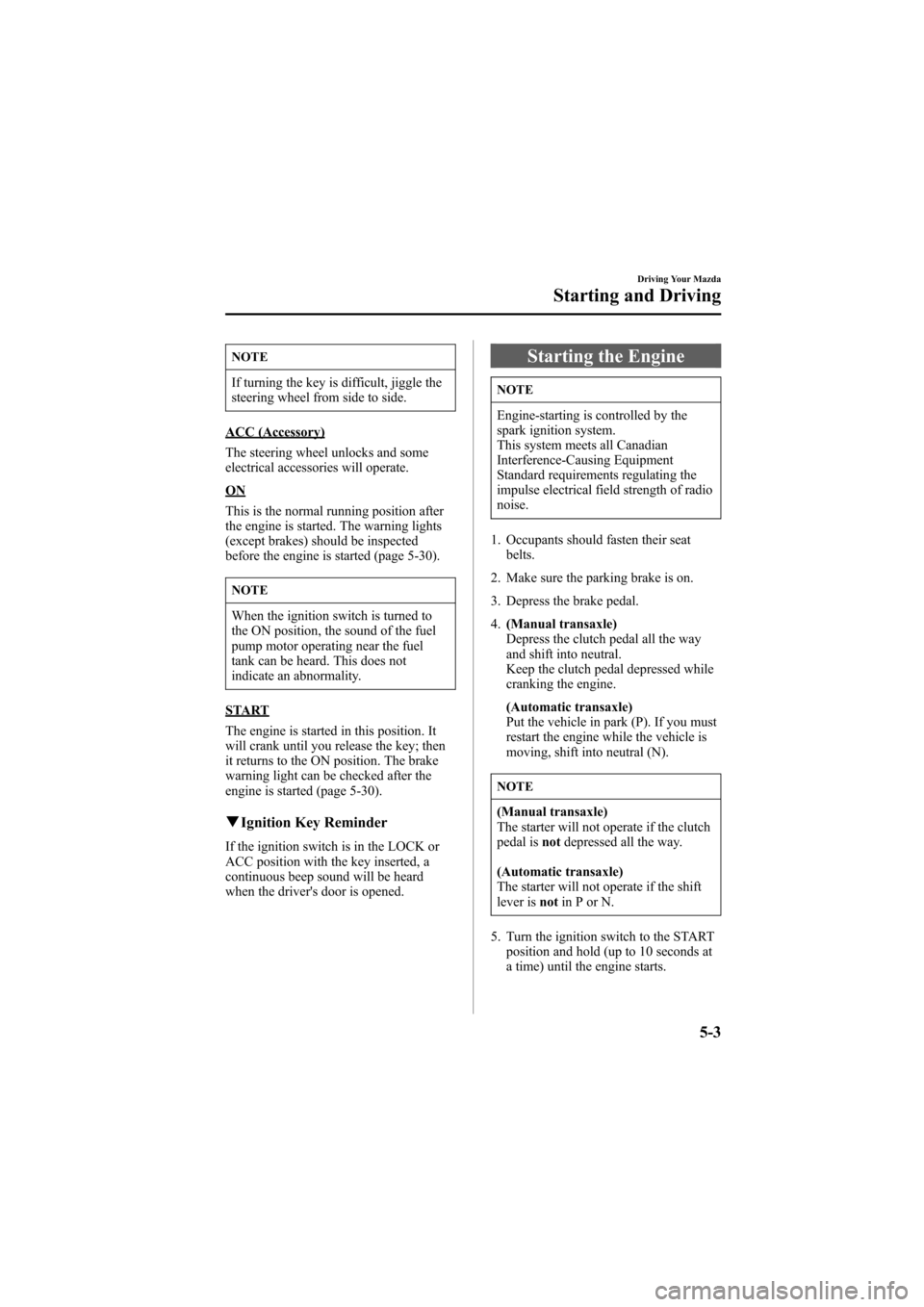
Black plate (137,1)
NOTE
If turning the key is difficult, jiggle the
steering wheel from side to side.
ACC (Accessory)
The steering wheel unlocks and some
electrical accessories will operate.
ON
This is the normal running position after
the engine is started. The warning lights
(except brakes) should be inspected
before the engine is started (page 5-30).
NOTE
When the ignition switch is turned to
the ON position, the sound of the fuel
pump motor operating near the fuel
tank can be heard. This does not
indicate an abnormality.
START
The engine is started in this position. It
will crank until you release the key; then
it returns to the ON position. The brake
warning light can be checked after the
engine is started (page 5-30).
qIgnition Key Reminder
If the ignition switch is in the LOCK or
ACC position with the key inserted, a
continuous beep sound will be heard
when the driver's door is opened.
Starting the Engine
NOTE
Engine-starting is controlled by the
spark ignition system.
This system meets all Canadian
Interference-Causing Equipment
Standard requirements regulating the
impulse electrical field strength of radio
noise.
1. Occupants should fasten their seat
belts.
2. Make sure the parking brake is on.
3. Depress the brake pedal.
4.(Manual transaxle)
Depress the clutch pedal all the way
and shift into neutral.
Keep the clutch pedal depressed while
cranking the engine.
(Automatic transaxle)
Put the vehicle in park (P). If you must
restart the engine while the vehicle is
moving, shift into neutral (N).
NOTE
(Manual transaxle)
The starter will not operate if the clutch
pedal isnotdepressed all the way.
(Automatic transaxle)
The starter will not operate if the shift
lever isnotin P or N.
5. Turn the ignition switch to the START
position and hold (up to 10 seconds at
a time) until the engine starts.
Driving Your Mazda
Starting and Driving
5-3
Mazda6_8U66-EA-05F_Edition1 Page137
Friday, June 3 2005 8:46 AM
Form No.8U66-EA-05F
Page 262 of 390

Black plate (262,1)
Jump-Starting
Jump-starting is dangerous if done incorrectly. So follow the procedure carefully. If you
feel unsure about jump-starting, we strongly recommend that you have a competent service
technician do the work.
WARNING
Eye Protection:
Working without eye protection is dangerous. Battery fluid contains SULFURIC
ACID which could cause blindness if splashed into your eyes. Also, hydrogen gas
produced during normal battery operation, could ignite and cause the battery to
explode. Always wear eye protection when working near the battery.
Spilled Battery Fluid:
Spilled battery fluid is dangerous.
Battery fluid contains SULFURIC ACID which could cause serious injuries if it gets
in eyes, skin or clothing. If this happens, immediately flush your eyes with water for
15 minutes or wash your skin thoroughly and get medical attention. Wear eye
protection and protective gloves to prevent contact with battery fluid.
Children and Batteries:
Allowing children to play near batteries is dangerous. Battery fluid could cause
serious injuries if it gets in the eyes or on the skin. Always keep batteries out of the
reach of children.
Keep Flames Away:
Flames and sparks near open battery cells are dangerous. Hydrogen gas, produced
during normal battery operation, could ignite and cause the battery to explode. An
exploding battery can cause serious burns and injuries. Keep all flames including
cigarettes and sparks away from open battery cells. When working near a battery, do
not allow metal tools to contact the positive (
) or negative () terminal of the
battery. Do not allow the positive () terminal to contact the vehicle body.
Battery-Related Explosion:
Flames and sparks near open battery cells are dangerous. Hydrogen gas, produced
during normal battery operation, could ignite and cause the battery to explode. An
exploding battery can cause serious burns and injuries. Keep all flames, including
cigarettes, and sparks away from open battery cells.
7-18
In Case of an Emergency
Emergency Starting
Mazda6_8U66-EA-05F_Edition1 Page262
Friday, June 3 2005 8:48 AM
Form No.8U66-EA-05F
Page 263 of 390

Black plate (263,1)
WARNING
Low Fluid Level or Frozen Battery:
Jump-starting a frozen battery or one with a low fluid level is dangerous. It may
rupture or explode, causing serious injury.
Don't jump-start a frozen battery or one with a low fluid level.
Connecting to Negative Terminal:
Connecting the end of the second cable to the negative () terminal of the discharged
battery is dangerous.
A spark could cause the gas around the battery to explode and injure someone.
Connect the negative cable to a good ground point away from the battery.
Connecting Jumper Cable to Moving Parts:
Connecting a jumper cable near or to moving parts (cooling fans, belts) is dangerous.
The cable could get caught when the engine starts and cause serious injury. Never
connect a jumper cable to or near any part that moves.
CAUTION
Use only a 12 V booster system. You can damage a 12 V starter, ignition system, and
other electrical parts beyond repair with a 24 V power supply (two 12 V batteries in
series or a 24 V motor generator set).
1. Make sure the booster battery is 12 V
and that its negative terminal is
grounded.
2. If the booster battery is in another
vehicle, don't allow the vehicles to
touch. Turn off the engine of the
vehicle with the booster battery and all
unnecessary electrical loads in both
vehicles.
3. Connect the jumper cables in the exact
sequence as in the illustration.
lConnect one end of a cable to the
positive terminal on the discharged
battery (1).
lAttach the other end to the positive
terminal on the booster battery (2).
lConnect one end of the other cable
to the negative terminal of the
booster battery (3).
In Case of an Emergency
Emergency Starting
7-19
Mazda6_8U66-EA-05F_Edition1 Page263
Friday, June 3 2005 8:48 AM
Form No.8U66-EA-05F
Page 270 of 390
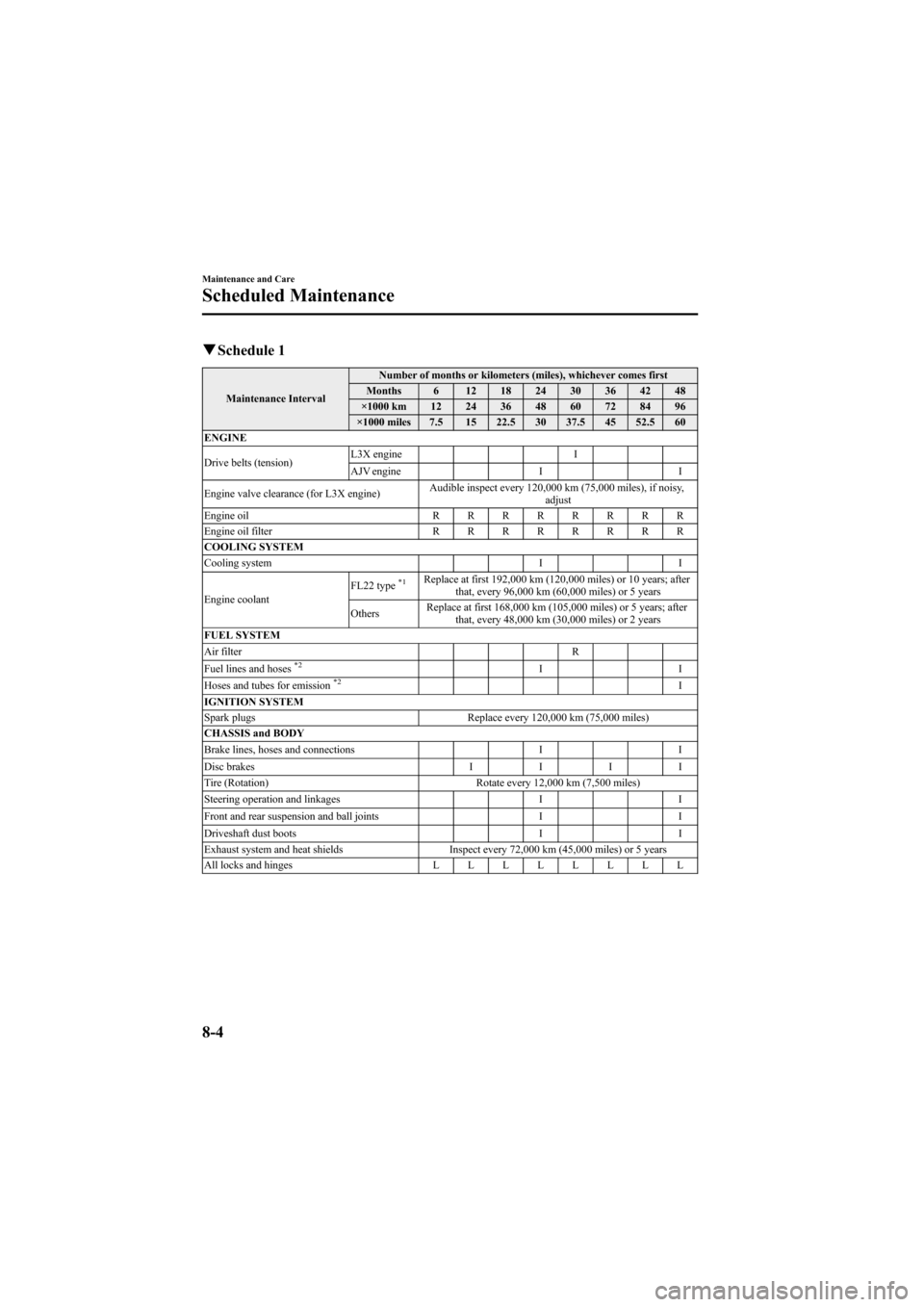
Black plate (270,1)
qSchedule 1
Maintenance IntervalNumber of months or kilometers (miles), whichever comes first
Months 6 12 18 24 30 36 42 48
×1000 km 12 24 36 48 60 72 84 96
×1000 miles 7.5 15 22.5 30 37.5 45 52.5 60
ENGINE
Drive belts (tension)L3X engine I
AJV engine I I
Engine valve clearance (for L3X engine)Audible inspect every 120,000 km (75,000 miles), if noisy,
adjust
Engine oilRRRRRRRR
Engine oil filterRRRRRRRR
COOLING SYSTEM
Cooling system I I
Engine coolantFL22 type
*1Replace at first 192,000 km (120,000 miles) or 10 years; after
that, every 96,000 km (60,000 miles) or 5 years
OthersReplace at first 168,000 km (105,000 miles) or 5 years; after
that, every 48,000 km (30,000 miles) or 2 years
FUEL SYSTEM
Air filter R
Fuel lines and hoses
*2II
Hoses and tubes for emission*2I
IGNITION SYSTEM
Spark plugs Replace every 120,000 km (75,000 miles)
CHASSIS and BODY
Brake lines, hoses and connections I I
Disc brakesIIII
Tire (Rotation) Rotate every 12,000 km (7,500 miles)
Steering operation and linkages I I
Front and rear suspension and ball joints I I
Driveshaft dust boots I I
Exhaust system and heat shields Inspect every 72,000 km (45,000 miles) or 5 years
All locks and hingesLLLLLLLL
8-4
Maintenance and Care
Scheduled Maintenance
Mazda6_8U66-EA-05F_Edition1 Page270
Friday, June 3 2005 8:48 AM
Form No.8U66-EA-05F
Page 272 of 390
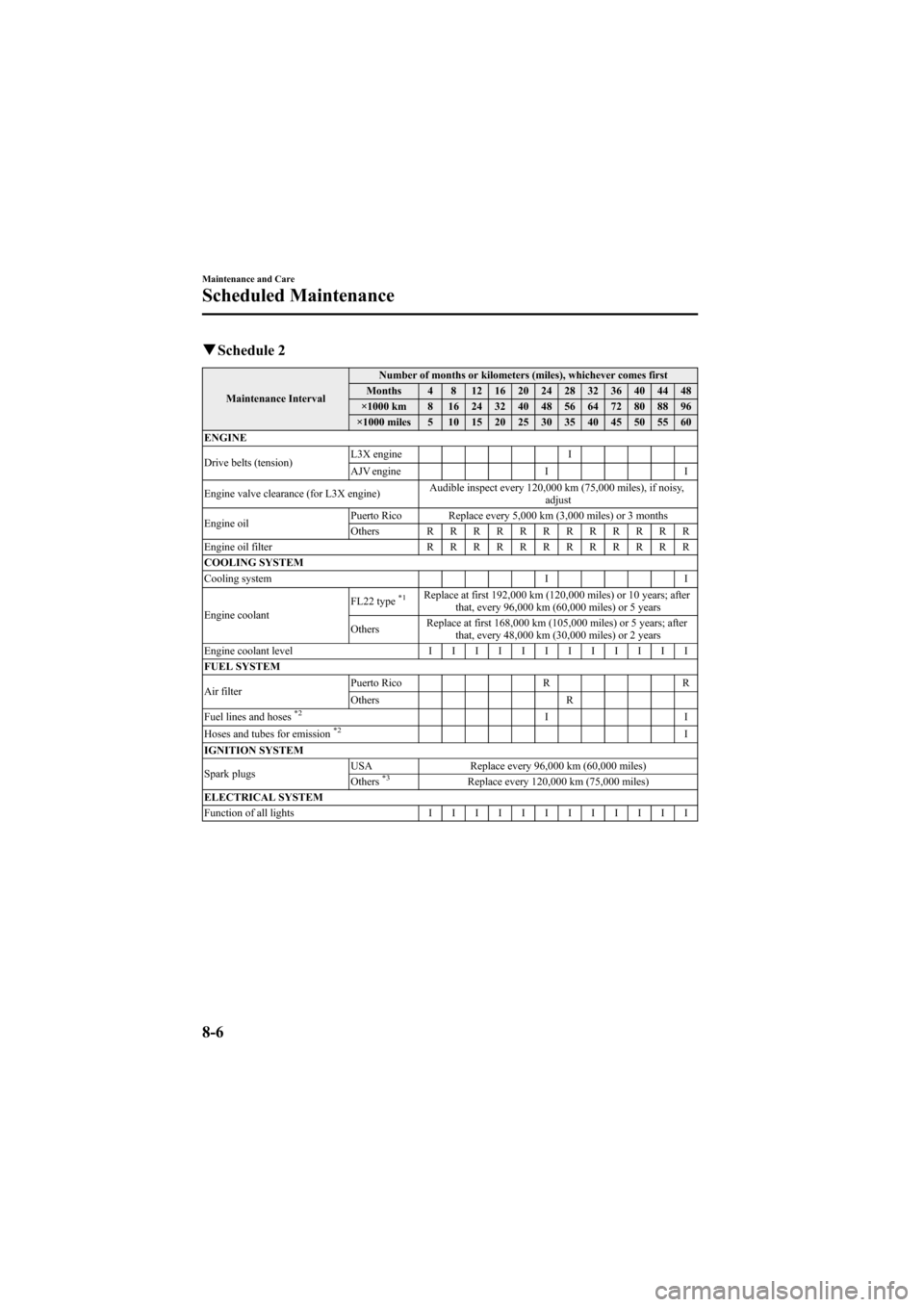
Black plate (272,1)
qSchedule 2
Maintenance IntervalNumber of months or kilometers (miles), whichever comes first
Months 4 8 12 16 20 24 28 32 36 40 44 48
×1000 km 8 16 24 32 40 48 56 64 72 80 88 96
×1000 miles 5 10 15 20 25 30 35 40 45 50 55 60
ENGINE
Drive belts (tension)L3X engine I
AJV engine I I
Engine valve clearance (for L3X engine)Audible inspect every 120,000 km (75,000 miles), if noisy,
adjust
Engine oilPuerto Rico Replace every 5,000 km (3,000 miles) or 3 months
OthersRRRRRRRRRRRR
Engine oil filterRRRRRRRRRRRR
COOLING SYSTEM
Cooling system I I
Engine coolantFL22 type
*1Replace at first 192,000 km (120,000 miles) or 10 years; after
that, every 96,000 km (60,000 miles) or 5 years
OthersReplace at first 168,000 km (105,000 miles) or 5 years; after
that, every 48,000 km (30,000 miles) or 2 years
Engine coolant levelIIIIIIIIIIII
FUEL SYSTEM
Air filterPuerto Rico R R
Others R
Fuel lines and hoses
*2II
Hoses and tubes for emission*2I
IGNITION SYSTEM
Spark plugsUSA Replace every 96,000 km (60,000 miles)
Others
*3Replace every 120,000 km (75,000 miles)
ELECTRICAL SYSTEM
Function of all lightsIIIIIIIIIIII
8-6
Maintenance and Care
Scheduled Maintenance
Mazda6_8U66-EA-05F_Edition1 Page272
Friday, June 3 2005 8:49 AM
Form No.8U66-EA-05F
Page 273 of 390
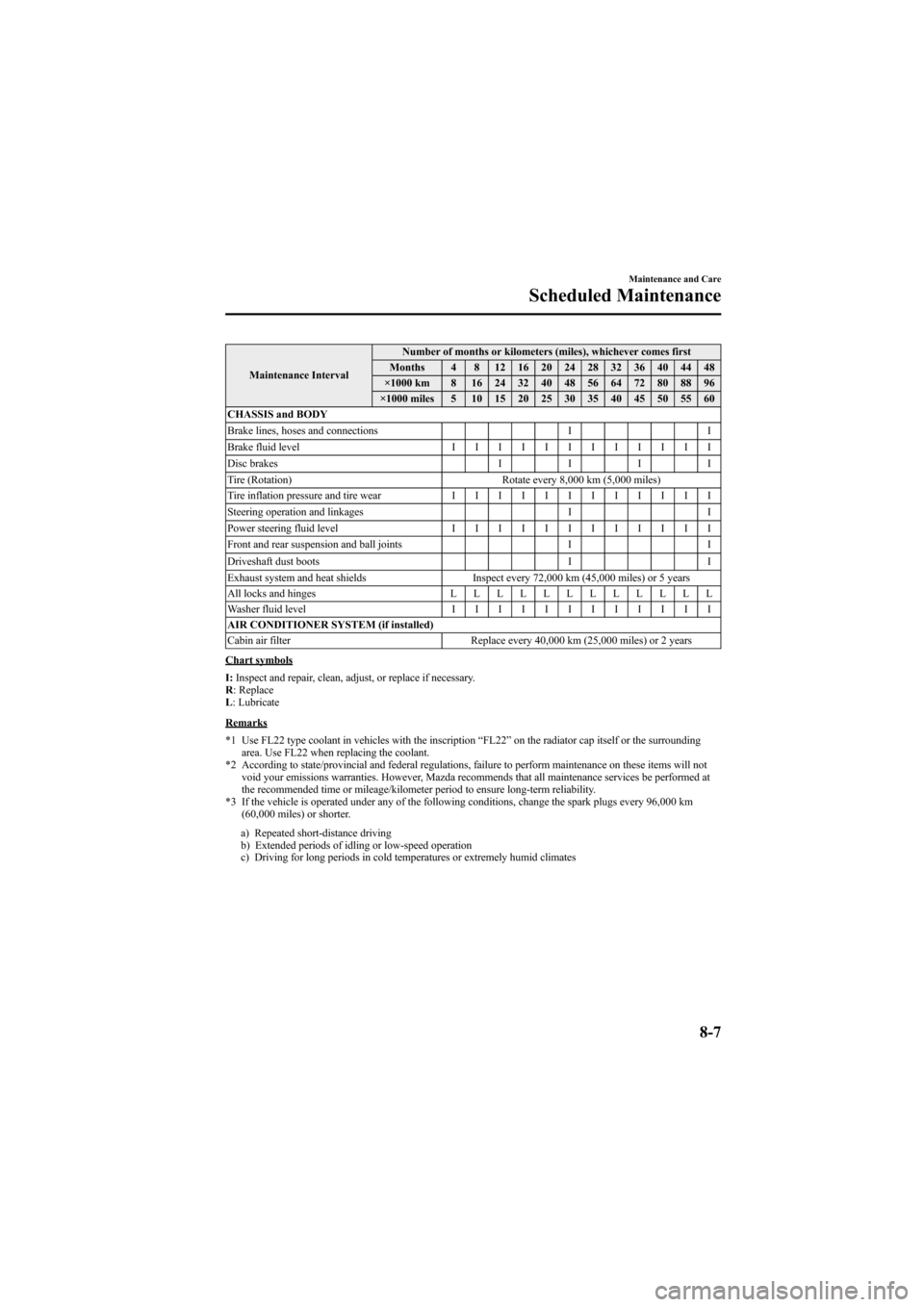
Black plate (273,1)
Maintenance IntervalNumber of months or kilometers (miles), whichever comes first
Months 4 8 12 16 20 24 28 32 36 40 44 48
×1000 km 8 16 24 32 40 48 56 64 72 80 88 96
×1000 miles 5 10 15 20 25 30 35 40 45 50 55 60
CHASSIS and BODY
Brake lines, hoses and connections I I
Brake fluid levelIIIIIIIIIIII
Disc brakesIIII
Tire (Rotation) Rotate every 8,000 km (5,000 miles)
Tire inflation pressure and tire wearIIIIIIIIIIII
Steering operation and linkages I I
Power steering fluid levelIIIIIIIIIIII
Front and rear suspension and ball joints I I
Driveshaft dust boots I I
Exhaust system and heat shields Inspect every 72,000 km (45,000 miles) or 5 years
All locks and hingesLLLLLLLLLLLL
Washer fluid levelIIIIIIIIIIII
AIR CONDITIONER SYSTEM (if installed)
Cabin air filter Replace every 40,000 km (25,000 miles) or 2 years
Chart symbols
I:Inspect and repair, clean, adjust, or replace if necessary.
R: Replace
L: Lubricate
Remarks
*1 Use FL22 type coolant in vehicles with the inscription“FL22”on the radiator cap itself or the surrounding
area. Use FL22 when replacing the coolant.
*2 According to state/provincial and federal regulations, failure to perform maintenance on these items will not
void your emissions warranties. However, Mazda recommends that all maintenance services be performed at
the recommended time or mileage/kilometer period to ensure long-term reliability.
*3 If the vehicle is operated under any of the following conditions, change the spark plugs every 96,000 km
(60,000 miles) or shorter.
a) Repeated short-distance driving
b) Extended periods of idling or low-speed operation
c) Driving for long periods in cold temperatures or extremely humid climates
Maintenance and Care
Scheduled Maintenance
8-7
Mazda6_8U66-EA-05F_Edition1 Page273
Friday, June 3 2005 8:49 AM
Form No.8U66-EA-05F
Page 275 of 390
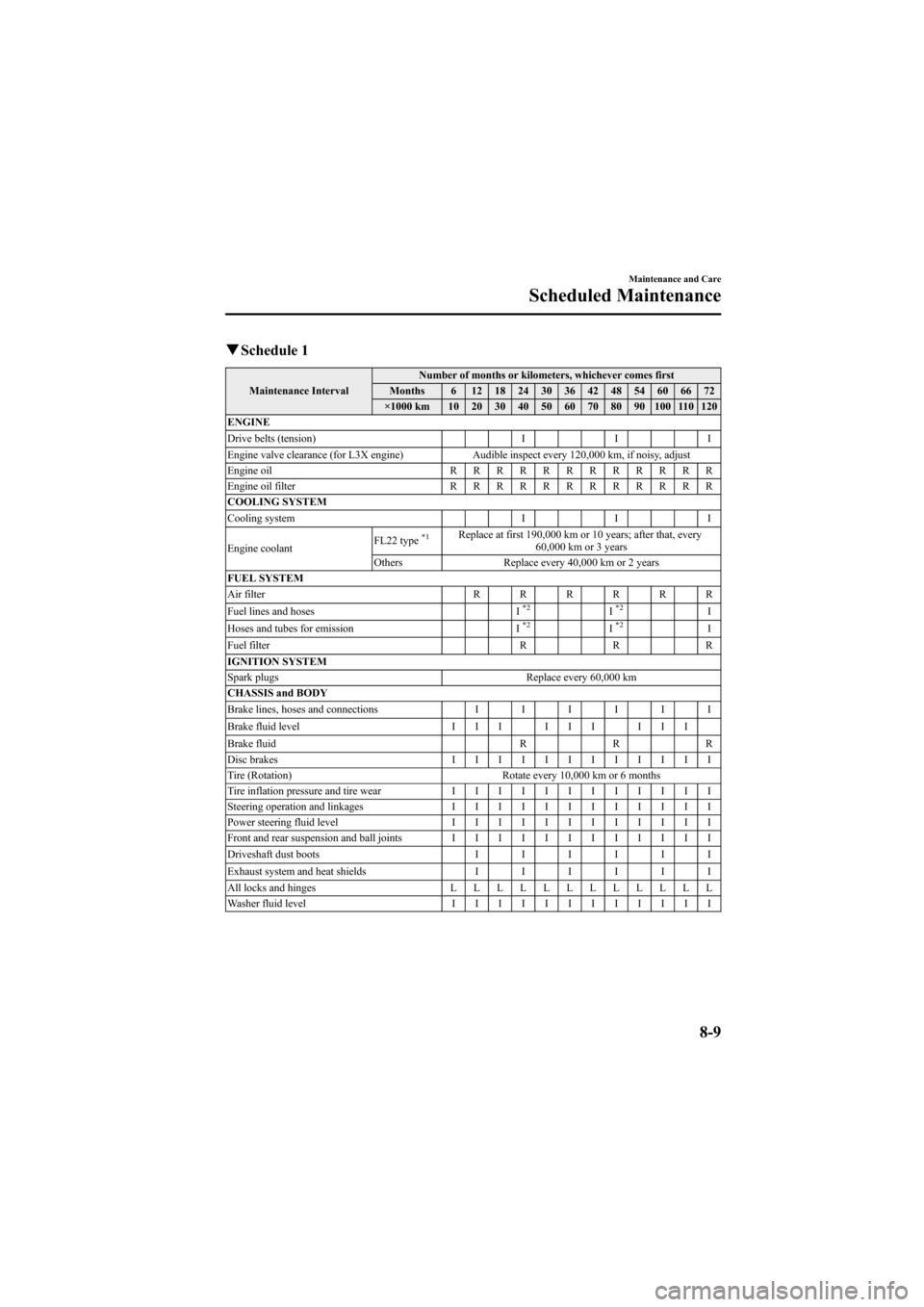
Black plate (275,1)
qSchedule 1
Maintenance IntervalNumber of months or kilometers, whichever comes first
Months 6 12 18 24 30 36 42 48 54 60 66 72
×1000 km 10 20 30 40 50 60 70 80 90 100 110 120
ENGINE
Drive belts (tension) I I I
Engine valve clearance (for L3X engine) Audible inspect every 120,000 km, if noisy, adjust
Engine oilRRRRRRRRRRRR
Engine oil filterRRRRRRRRRRRR
COOLING SYSTEM
Cooling system I I I
Engine coolantFL22 type
*1Replace at first 190,000 km or 10 years; after that, every
60,000 km or 3 years
Others Replace every 40,000 km or 2 years
FUEL SYSTEM
Air filterRRRRRR
Fuel lines and hoses I
*2I*2I
Hoses and tubes for emission I*2I*2I
Fuel filter R R R
IGNITION SYSTEM
Spark plugs Replace every 60,000 km
CHASSIS and BODY
Brake lines, hoses and connectionsIIIIII
Brake fluid level I I I I I I I I I
Brake fluid R R R
Disc brakesIIIIIIIIIIII
Tire (Rotation) Rotate every 10,000 km or 6 months
Tire inflation pressure and tire wearIIIIIIIIIIII
Steering operation and linkagesIIIIIIIIIIII
Power steering fluid levelIIIIIIIIIIII
Front and rear suspension and ball jointsIIIIIIIIIIII
Driveshaft dust bootsIIIIII
Exhaust system and heat shieldsIIIIII
All locks and hingesLLLLLLLLLLLL
Washer fluid levelIIIIIIIIIIII
Maintenance and Care
Scheduled Maintenance
8-9
Mazda6_8U66-EA-05F_Edition1 Page275
Friday, June 3 2005 8:49 AM
Form No.8U66-EA-05F
Page 277 of 390
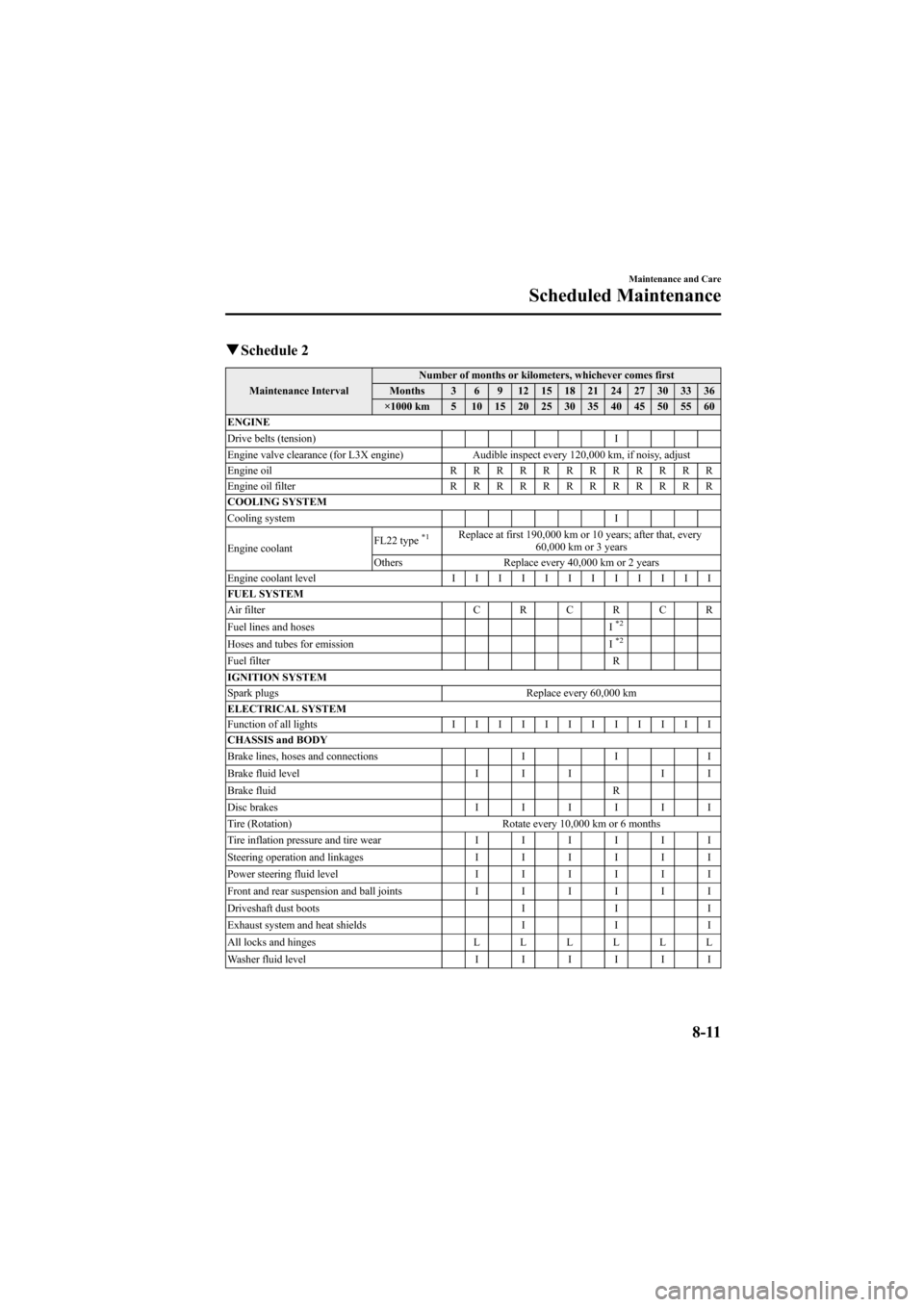
Black plate (277,1)
qSchedule 2
Maintenance IntervalNumber of months or kilometers, whichever comes first
Months 3 6 9 12 15 18 21 24 27 30 33 36
×1000 km 5 10 15 20 25 30 35 40 45 50 55 60
ENGINE
Drive belts (tension) I
Engine valve clearance (for L3X engine) Audible inspect every 120,000 km, if noisy, adjust
Engine oilRRRRRRRRRRRR
Engine oil filterRRRRRRRRRRRR
COOLING SYSTEM
Cooling system I
Engine coolantFL22 type
*1Replace at first 190,000 km or 10 years; after that, every
60,000 km or 3 years
Others Replace every 40,000 km or 2 years
Engine coolant levelIIIIIIIIIIII
FUEL SYSTEM
Air filterCRCRCR
Fuel lines and hoses I
*2
Hoses and tubes for emission I*2
Fuel filter R
IGNITION SYSTEM
Spark plugs Replace every 60,000 km
ELECTRICAL SYSTEM
Function of all lightsIIIIIIIIIIII
CHASSIS and BODY
Brake lines, hoses and connections I I I
Brake fluid level I I I I I
Brake fluid R
Disc brakesIIIIII
Tire (Rotation) Rotate every 10,000 km or 6 months
Tire inflation pressure and tire wearIIIIII
Steering operation and linkagesIIIIII
Power steering fluid levelIIIIII
Front and rear suspension and ball jointsIIIIII
Driveshaft dust boots I I I
Exhaust system and heat shields I I I
All locks and hingesLLLLLL
Washer fluid levelIIIIII
Maintenance and Care
Scheduled Maintenance
8-11
Mazda6_8U66-EA-05F_Edition1 Page277
Friday, June 3 2005 8:49 AM
Form No.8U66-EA-05F